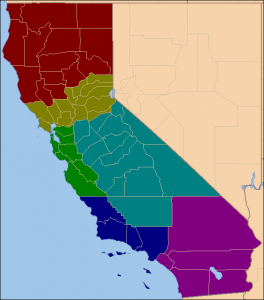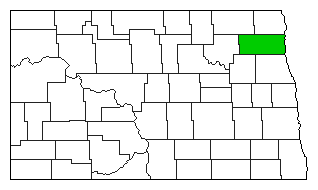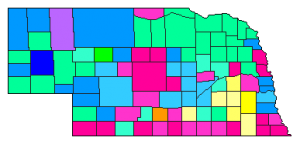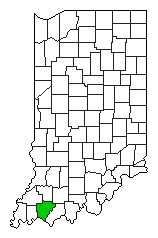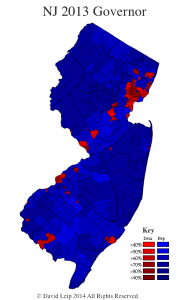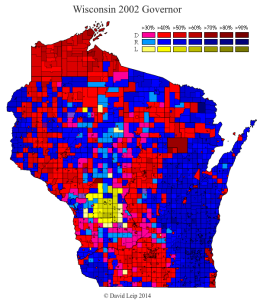The Atlas User Endorsements feature for 2014 U.S. Senate and Governor are now active. Create a map for your favorite candidates for U.S. Senate and Governor in the 2014 General Election.
2012 Presidential Election with Six Californias
The Six Californias Initiative is in the news for having submitted signatures for a ballot measure to split the state of California into six smaller states. How would such a dramatic change have impacted the 2012 General Election for President?
The proposed states are defined as follows: Jefferson (red), consisting of 14 counties in the north of the state to the Oregon Border, North California (gold) consisting of 13 counties running north of San Francisco to Lake Tahoe, Silicon Valley (green) consisting of eight counties from Contra Costa to Monterey, Central California (cyan) consisting of 14 counties north of Los Angeles and south of Sacramento, West California consisting of the four counties of Los Angeles, Ventura, San Luis Obispo, and Santa Barbara, and South California (magenta) consisting of the five counties in the southern part of the state south and east of Los Angeles.
To determine the number of Presidential Electors for the six new states, the representatives apportioned to each state is calculated using the Method of Equal Proportions based on the population figures from the 2010 U.S. Census. Jefferson would become the seventh smallest state with more population than Delaware but less than Montana any have only one representative. North California would have five, Silicon Valley nine, Central California six, West California 16, and South California 15. The combined number of representatives of the six Californias is 52, one fewer than the whole of California today. The one representative lost by the “Californias” is picked up by North Carolina. However, the six Californias would pick up 10 new U. S. Senators, for a total of 64 electoral votes in all (nine more than the current 55 electoral votes). The table below shows the breakdown of the total representatives and electoral votes for the proposed states, assuming that the size of the House of Representatives remains at 435.
| Proposed State | Population (2010) | Rep | Sen | EV |
|---|---|---|---|---|
| Jefferson | 949,240 | 1 | 2 | 3 |
| North California | 3,742,229 | 5 | 2 | 7 |
| Silicon Valley | 6,597,332 | 9 | 2 | 11 |
| Central California | 4,124,776 | 6 | 2 | 8 |
| West California | 11,335,455 | 16 | 2 | 18 |
| South California | 10,504,924 | 15 | 2 | 17 |
The Presidential Election results for these six states are quite interesting. Three of the states – Jefferson, Central California, and South California – are competitive with a margin of victory less than 3.5%. Romney wins Jefferson and Central California, while Obama wins the remaining four. The table below shows the data.
| Proposed State | Total Vote | Margin | % | %O | %R | Vote Obama | Vote Romney |
|---|---|---|---|---|---|---|---|
| Jefferson | 381,322 | 12,347 | 3.2% | 46.0% | 49.3% | 175,551 | 187,898 |
| N. California | 1,536,378 | 289,964 | 18.9% | 57.9% | 39.0% | 889,742 | 599,778 |
| Silicon Valley | 2,590,814 | 1,295,981 | 50.0% | 73.5% | 23.5% | 1,904,135 | 608,154 |
| C. California | 1,147,447 | 31,011 | 2.7% | 47.3% | 50.0% | 542,933 | 573,994 |
| W. California | 3,798,630 | 1,385,355 | 36.5% | 67.0% | 30.5% | 2,543,219 | 1,157,864 |
| S. California | 3,601,224 | 86,385 | 2.4% | 50.0% | 47.6% | 1,798,705 | 1,712,320 |
The electoral vote breakdown from the six Californias is 11 for Romney and 53 for Obama, with an additional one vote for Romney picked up in North Carolina due to the apportionment of one more representative to North Carolina as mentioned above. The overall electoral vote total is: Obama 330 to Romney 218. The national electoral vote map for this scenario is shown below:
Forum discussion topic is located here.
2012 Election Results Updated for Warrick County, IN
The updated 2012 general election results for Warrick County, IN have been released by the Warrick County Election Office. On March 3, 2014, it was announced that thousands of ballots were not reported in the 2012 general election due to error. The new report includes the addition of 3,790 absentee ballots omitted from the original report. However, the new report omits one military ballot and four provisional ballots (the four provisional ballots were counted in the original report). For President, the outstanding ballots are statistically similar to the ballots originally counted, with a nearly identical percentage for Romney, a slightly higher percentage for Obama, and only half the percentage for Johnson. The table below shows the comparison:
Warrick County, IN Ballot Comparison
| Candidate | Original | Audited | Change | % Change |
|---|---|---|---|---|
| Total Ballots | 24,984 | 28,770 | 3,786 | 15.2% |
| Mitt Romney | 15,351 | 17,680 | 2,329 | 15.2% |
| Barack Obama | 8,793 | 10,181 | 1,388 | 15.8% |
| Gary Johnson | 486 | 523 | 37 | 7.6% |
All online databases and store files for US President, US Senate, Governor, and US House of Representatives have been updated to reflect this update.
Reports: Warrick 2012 Summary : Warrick 2012 Post Audit Summary
Walsh County, ND 2012 Vote Recanvassed in 2013
Walsh County, ND data for 2012 have been updated on the atlas to reflect the recanvass of the results by the County Auditor in April, 2013. The Auditor said that there were insufficient ballots printed for the 2012 General Election, and to accommodate the voters, photocopies were made and then hand counted. This resulted in some confusion and the results were recanvassed in April of 2013. The net result was a small decrease in the official totals across all offices and all candidates. Romney’s net vote dropped by 157 from 2,813 to 2,656 and Obama lost 139 votes from 2,124 to 1,985. Similar vote reductions occurred for candidates for U.S. Senate, U.S. House of Representative, and Governor.
Nebraska 2014 Republican Gubernatorial Primary
The Nebraska 2014 Republican Gubernatorial Primary was a competitive six-way contest with a very flat result. No candidate received more than 27% of the vote, four candidates received more than 19%, and every one of the six candidates won in at least one county. Omaha businessman Pete Ricketts came out on top with a preliminary unofficial total of 26.5% (57,922 votes), followed closely by Nebraska Attorney General Jon Bruning at 25.49% (55,751 votes), State Senator Beau McCoy at 20.94% (45,804 votes), and State Auditor Mike Foley with 19.22% (42,029 votes). Trailing were Tax attorney Bryan Slone with 4.13% and State Senator Tom Carlson with 3.74%. Across the state, only three counties were won with more than 40% of the vote – the top one being Phelps County won by fifth place finisher Carlson with 49.7% (his home town is Holdrege located in Phelps County), Ricketts won Morrill County (in the panhandle) with 42%, and Foley won Lancaster County with 41%. The table below summarizes the results:
Nebraska 2014 Republican Primary Results (Unofficial)
| Candidate | Total Votes | Percentage | Counties Won | |
|---|---|---|---|---|
 | Pete Ricketts | 57,922 | 26.48% | 26 |
 | Jon Bruning | 55,751 | 25.49% | 32 |
 | Beau McCoy | 45,804 | 20.94% | 27 |
 | Mike Foley | 42,029 | 19.22% | 7 |
 | Tom Carlson | 9,034 | 4.13% | 1 |
 | Bryan Slone | 8,179 | 3.74% | 1 |
The Pie chart at right is the statewide breakdown of the vote for the six candidates. Rickett’s strongest vote margins were in the Omaha area of Douglas and Sarpy Counties, where he had a combined margin advantage of 5,427 votes. Fourth-place finisher, Foley, had the highest-margin county in Lancaster, where he topped Bruning by 5,986 votes and Ricketts by 6,363 votes. However, he did not have sufficient state-wide support to achieve victory. Bruning’s support was more dispersed, winning the most counties, concentrated in the north and west, but not having any high-margin counties. McCoy is similar to Bruning, with his support concentrated in the central and southern portions of the state. Carlson and Slone both had more than 30% support in only a single county each. Below is a full interactive mouse-over map.
Polk County has the smallest win percentage, where Bruning won with 310 votes (24.12%) to 306 for Foley, 302 for Ricketts, 299 for McCoy, Carlson at 50, and Slone at 18. An almost even 4-way split! The full results page on the atlas is located here.
New Election Data Sets for U.S. House 1992-1998
Now available for purchase are election data sets for U.S. House of Representatives by county, congressional district, and state in the general elections of 1992, 1994, 1996, and 1998. There have been many requests for these data, and after several months of compilation, the files are now available for purchase on the store page.
Note that the status of the files is listed as “Preliminary” because the Commonwealth of Pennsylvania did not publish official results by county for U.S. House of Representatives in those years. The data included in the files in a mix of official results obtained from a few individual counties and compiled results from a precinct-level database provided by the Pennsylvania Bureau of Commissions, Elections and Legislation – but like many such databases, there are many discrepancies. It will take several more months to track down the individual results from each of the county election agencies. The data as-is is quite usable since most of the discrepancies are a small percentage of the totals.
As always, updates to purchased data sets are free.
Warrick County Clerk Discovers 3,791 Uncounted Ballots
The Warrick County, Indiana Clerk has recently announced a discovery that 3,791 early ballots cast in the 2012 General Election were left uncounted in the official results published. Looking at the data, a comparison of the ballots cast in 2008 and 2012 show an overall decline in total ballots cast of 4,211 (29,195 ballots were cast in 2008 vs 24,984 cast in 2012 – a decline of 14%). This compares with a 4.6% decline in overall turnout state-wide. More strikingly, the total number of absentee ballots dropped from 10,372 to 1,981 or 81%! Another anomaly shows that the number of machine ballots increased to 22,999 from 18,823, an increase of 4,176 votes (22% increase). These data compare with the county voter registration increase of 3,367 voters (+7.2%), causing the overall turnout to fall from 62.5% to 49.9%. The table below summarizes the data:
| Ballots | 2008 | 2012 | Change | |
|---|---|---|---|---|
| Machine | 18,823 | 22,999 | 4,176 | +22.2% |
| Absentee | 10,372 | 1,981 | -8,391 | -80.9% |
| Total | 29,195 | 24,984 | -4,211 | -14.4% |
| Reg Voters | 46,718 | 50,085 | 3,367 | +7.2% |
| Turnout | 62.5% | 49.9% | -12.6% | |
The turnout of 49.9% voter turnout ranks Warrick fourth from the bottom (89th place), just ahead of Clinton, Switzerland, and Scott. In 2008, Warrick was right in the middle of the pack (40th place). Below is a chart that shows the Warrick County normalized voter turnout from 1980 to 2012 (vs. Registered Voters). This is calculated by subtracting the statewide voter turnout from the voter turnout in Warrick County.
Warrick County, IN Normalized Turnout
The chart highlights the significant decline in normalized turnout for 2012, well outside the normal variable range for the county, pointing to a high probability of an error. Thus far, the Warrick County Clerk has not published an update to the official county vote results for the 2012 General Election. The Atlas will be updated when this occurs. Thanks to Jeff Singer for the tip.
New Jersey 2013 Governor by Municipality
The municipality map for the 2013 race for Governor in New Jersey is complete and shown at right. In this solid Republican win for incumbent Governor Chris Christie, he carried 503 municipalities vs. only 61 won by Democratic challenger Barbara Buono. This is a significant improvement over Christie’s election in 2009 vs. John Corzine, where he won 413 municipalities to Corzine’s 152 (an overall net pickup of 90 for Christie). Buono carried the largest two municipalities of Newark and Jersey City, but only one other (Patterson) in the top 29 municipalities ranked by total votes cast. Buono’s strongest municipality with over 1,000 votes cast was in East Orange (Essex County) where she won 87.6% to 11.3% (a margin of 8,201 votes). Similarly, Christie’s strongest municipality with greater than 1,000 votes cast was in Colts Neck (Monmouth County) , where he won 83.4% to 15.1% (a margin of 2,152 votes). The table below summarizes the contest data:
| Gubernatorial Candidate | Lt.Gubernatorial Candidate | Political Party | Popular Vote | % | |
|---|---|---|---|---|---|
 | Chris Christie | Kimberly Guadagno | Republican | 1,278,932 | 60.24% |
 | Barbara Buono | Milly Silva | Democratic | 809,978 | 38.15% |
 | Kenneth Kaplan | Brenda Bell | Libertarian | 12,155 | 0.57% |
 | Steven Welzer | Patricia Alessandrini | Green | 8,295 | 0.39% |
 | Others | - | - | 13,681 | 0.64% |
Buono’s strength was limited to the urban centers surrounding Camden, Trenton, and Newark, while Christie was strong everywhere else – especially in Ocean County and the northwestern portions of the state. Full detailed maps can be viewed on the Atlas page. Forum discussion on this contest is located in this thread.
Wisconsin 2002 Gubernatorial Map by Municipality
At right is the Wisconsin 2002 General Election Result map for Governor by municipality. This contest was between incumbent Republican Governor Scott McCallum (whom assumed office when Governor Tommy Thompson resigned to become the U.S. Secretary of Health and Human Services in January of 2001), the Democratic candidate Attorney General Jim Doyle, the Libertarian Mayor of Tomah Ed Thompson (the younger brother of former Governor Tommy Thompson), the Green party candidate Jim Young, and several other minor party candidates. The statewide results of the election are summarized in the table below (full statewide results available here):
Wisconsin 2002 General Election Result for Governor
| Gubernatorial Candidate | Lt. Gubernatorial Candidate | Political Party | Popular Vote | % | |
|---|---|---|---|---|---|
 | James Doyle | Barbara Lawton | Democratic | 800,515 | 45.09% |
 | Scott McCallum | Margaret Farrow | Republican | 734,779 | 41.39% |
 | A. Ed Thompson | Martin Reynolds | Libertarian | 185,455 | 10.45% |
| James Young | Jeff Peterson | WI Green | 44,111 | 2.48% | |
| Others | - | - | 10,489 | 0.59% |
The results show an even split in the number of municipalities carried by Republican Scott McCallum and Democrat James Doyle. Doyle won 896 municipalities, with strong showing in the City of Milwaukee, Dane County through the central part of the state and in the Northwest counties of Douglas, Bayfield, and Ashland. Scott McCallum won in 905 municipalities, showing strength in the east of the state, from the Milwaukee western suburbs, north and east through the Eastern Ridges and Lowlands. Libertarian Candidate Ed Thompson won 72 municipalities, mostly centered around his home City of Tomah (where he won Monroe County as well as neighboring Juneau County). The overall margin of victory for James Doyle was 65,736 votes – fewer than his 93,126 vote margin in just two municipalities – Milwaukee, where he won 65.8% to 26.4% over his Republican Challenger, a margin of 55,420 votes and in Madison, where he won 62.8% to 18.8% (with 10.5% for Ed Thompson), a margin of 37,706 votes.
The candidates’ best counties with more than 1,000 votes are
- Doyle: Superior (Douglas County) with 68.2% to 23.4% for McCallum and 4.5% for Thompson
- McCallum: Oostburg (Sheboygan County) with 75.9% to 24.14% for Doyle and 5.15% for Thompson
- Thompson: Tomah (Monroe County) with 55.8% to 22.4% for Doyle and 20.4% for McCallum
More information and maps are available on the Atlas town map page for the 2002 Gubernatorial Results – Wisconsin. Atlas Forum topic on this result is located here.
Virginia 2013 Gubernatorial Swing Map
The margin swing in the 2013 Virginia Governor’s race relative to the 2009 election was nearly 20% towards the Democrats. The 2013 result was Democrat Terry McAuliffe over Republican Ken Cuccinelli by 2.6% (47.8%-45.2%). In the 2009 contest, Republican Bob McDonnell defeated Democrat Creigh Deeds by 17.3% (58.6%-41.3%). As shown by the map, most of the counties and cities in the state swung Democratic. A dozen counties in the Appalachian region bordering West Virginia plus Patrick County swung Republican. Most of these had relatively modest Republican swings. An exception to this, however, are three adjacent counties in the northwest portion of the state: Alleghany, Bath, and Highland along with Covington City (which lies wholly within Alleghany County). These three counties plus city exhibited swing percentages that significantly bucked the statewide swing, recording vote margins that surged Republican by 31%, 51%, 21%, and 26% respectively. Bath County in particular, with a Republican swing percentage of 51% makes for a state-level trend move of 71% (51% Republican swing in the county plus 20% Democratic swing statewide).
Virginia 2013 Governor - Margin Swing
| County | Margin 2009 | Margin 2013 | Margin Swing |
|---|---|---|---|
| Bath County | D+27% | R+24% | R+51% |
| Allegheny County | D+23% | R+9% | R+31% |
| Covington City | D+32% | D+6% | R+26% |
| Highland County | R+10% | R+31% | R+21% |
| Statewide | R+17% | D+3% | D+20% |
While often such outlying data can suggest an error in the tally, this result is simply a matter of the area voting for favorite son Creigh Deeds in 2009 and returning to the regional voting pattern in 2013. Creigh Deeds is from Bath County and represented the 25th district in the Virginia Senate (In 2009, Bath County, Allegheny County, and Covington City were all within the 25th district). These counties also have very small populations (in 2013, Highland County had only 903 total votes counted, Bath County had 1,213, Allegheny County had 4,136, and Covington City had 1,275). The full swing table (member feature) can be viewed here.





